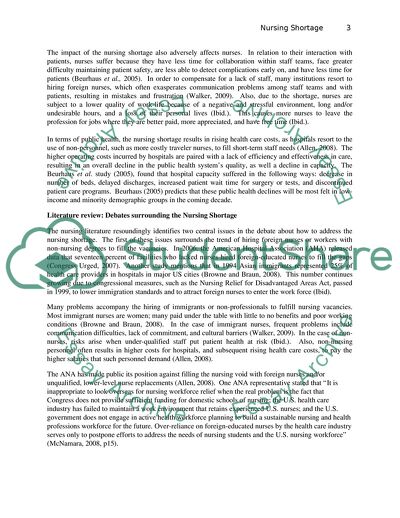
- Home
- Free Samples
- Premium Essays
- Editing Services
- Extra Tools
- Essay Writing Help
- About Us
- Studentshare
- Subjects
- Miscellaneous
- Nursing shortage (nursing care issue paper)
Nursing shortage (nursing care issue paper) - Essay Example

- Subject: Miscellaneous
- Type: Essay
- Level: Undergraduate
- Pages: 4 (1000 words)
- Downloads: 0
- Author: barryfriesen
Extract of sample "Nursing shortage (nursing care issue paper)"
While measures taken at local, state, and national levels have resulted in a renewed interest in the nursing profession, factors such as a lack of academic faculty and funding, and an aging nursing population, among many others, maintain the nursing shortage as a primary problem in most hospitals (Beurhaus, 2005). This paper will describe the impacts of the nursing shortage on health care consumers, nurses, and public health. It will examine the debate surrounding the nursing shortage and explain how the issue is being addressed on local, state, and national levels.
Finally, the paper will propose some ideas for minimizing the nursing shortage problem. The shortage of nurses in America’s hospitals results in negative impacts for health care consumers, nurses, and the health care system. A survey conducted by Beurhaus et al. (2005) examined the experience of RNs, physicians, hospital CEOs and CNOs with the nursing shortage and analyzed the results in terms of nurses’ ability to meet the six Institute of Medicine (IOM)-established aims for high quality health care systems: patient-centered, effective, safe, timely, efficient, and equitable.
The survey found that each of these criteria for quality of care suffered due to the nursing shortage (ibid.). In terms of direct patient care, the nursing shortage results in a decline in the quality of patient care. The Beurhaus et al. survey (2005), found that patient care suffered specifically because of a delayed response by nurses to pages or calls, patients increasingly complaining about care, staff communication problems, and increasing physicians’ workloads. The results of the decline in patient care are worrisome.
An American Nurses Association (ANA) fact sheet about the national nursing shortage (2008) highlights the results of recent studies published in medical journals that show how the shortage puts patient’s lives in danger: “Every additional full-time nurse per patient
...Download file to see next pages Read More
- TERMS & CONDITIONS
- PRIVACY POLICY
- COOKIES POLICY